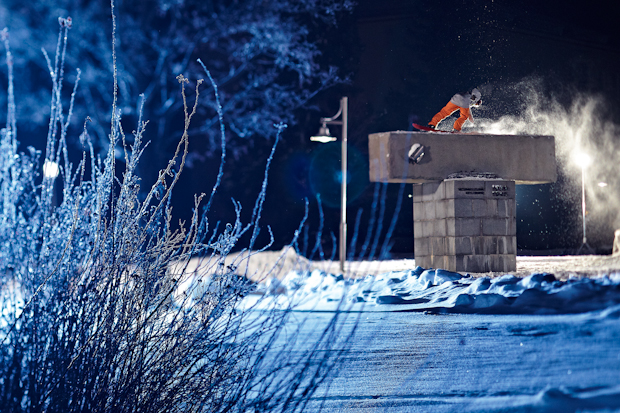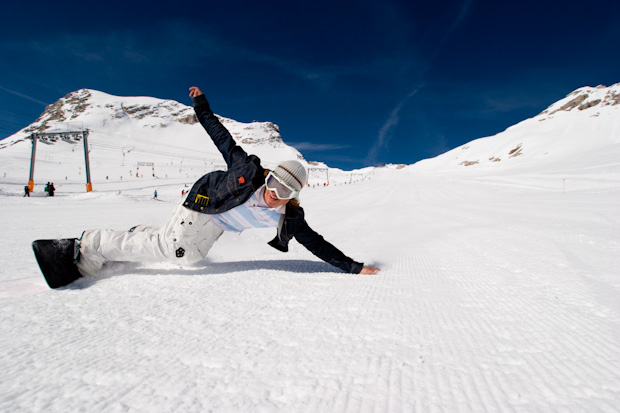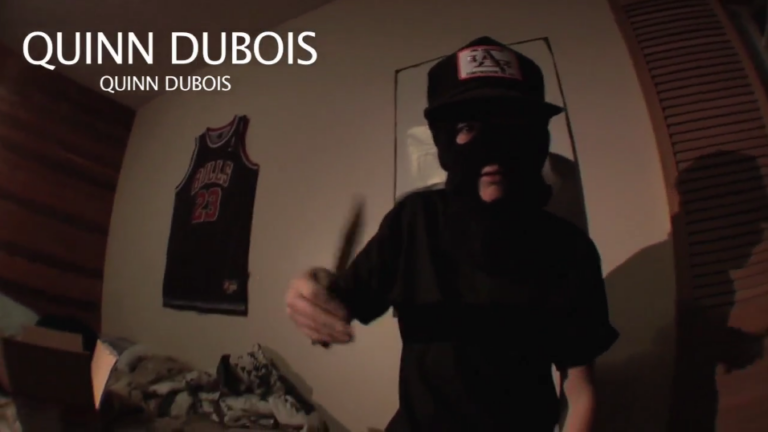Taken from Whitelines Issue 102 Spring 2012
Interview: Ed
Photos: Oli Gagnon
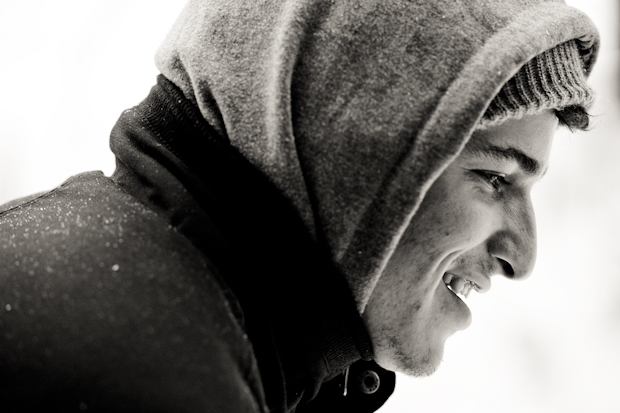
It’s hard to believe now, but in the mid 90s jibbing was dying a death. The philosophy of movie-makers was simple: bigger is better. Big jumps, big cliffs, big lines in AK. Though freestyle sections from guys like Jamie Lynn or Terje might include the odd park bonk, the raison d’être of almost every shred film was powder, and in Creatures of Habit 2, jibbers were even caracatured as sponsor-chasing wannabees, spinning around on tree stumps with their insanely wide stances and tent-like trousers. Everything changed when Mike ‘Mack Dawg’ McEntire, a former skate filmer from San Francisco, took to the hills with a new group of kids including fresh-faced Utah locals JP Walker and Jeremy Jones. The combination of Mack Dawg’s raw editing style and JP’s rail slaying skills hit snowboarding like a slap in the face and the rest, as they say, is history.
“The first video I watched, like over a hundred times, was [Mack Dawg’s] Decade” says Louis-Félix Paradis, his thick French-Canadian accent coming over a crackly Skype line. ‘Louif’, as he’s known, is one of the current generation of jibbers pushing snowboarding into new creative realms. Right now, he’s the image of the modern professional snowboarder – plugged into his laptop in an airport, en route to a distant continent. Though the tight jeans and even tighter stances of some of his friends might seem a world away from those early urban sections, he’s well aware of the MDP influence: “I looked up to JP Walker, Jeremy Jones and those other guys ‘cos I could really relate to what they were doing,” he explains. “They were sliding rails, benches and picnic tables, and I could find that all around my house. It was something I could mimic in the nearest park.”
“I have some of my favourite days riding powder, but street stuff is where I feel I can do something new, to add to what’s happening in the snowboard world”
Ah yes, the parks of Quebec. Louif grew up in one of the world’s coldest cities, in what is now a mecca for urban riding. Having started out just sledging on the local hills with his brother, before standing on his toboggan sideways, it was only natural that when he progressed to a real board he’d make the most of the urban terrain. “The mountains in Quebec are pretty small,” he says. “The trees are tight and you’ve gotta drive pretty far to get to the backcountry. It’s nothing compared to the West Coast. But the city is pretty cool. Quebec is built on a hill so there’s a bunch of natural obstacles, and there are loads of old buildings and monuments. And since there’s usually snow everywhere, and natural banks, we just do a lot of urban stuff.”
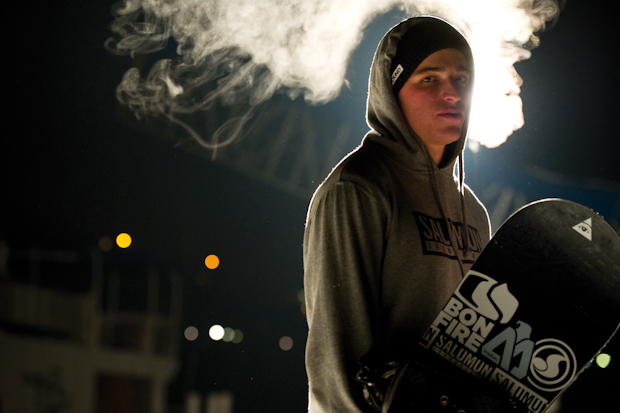
He’s obviously proud of his hometown, which is not surprising – the Eastern province of Quebec is fiercely independent, with some locals even calling for political separation. I ask him if he sees himself as Canadian or Quebecois. “I feel Quebecois maybe more,” he replies after some thought. “Like I feel a difference between us French-speaking Canadians and all the rest of the English speakers. But I’m super stoked to be part of the whole country too.”
So if jibbing should ever follow halfpipe and slopestyle into the Olympics, with a full-blown street contest, would he heed the call to represent the famous maple leaf? The idea takes him aback, not because of a lack of national pride but because the concept seems so alien. “They’d have to be sell it to me very well!” he says at first, before thinking some more. “No, I don’t think it has a place in the Olympics,” he finally concludes. “Slopestyle is fine, but street stuff…? I dunno, it’d lose a lot of its authenticity. There’s so many subtleties that the general public don’t really see when they look at what we do – like little things to do with style. It’s not always about going the biggest, it’s also about being technical. I don’t think it’s made for a TV crowd at all. It should stay a little low, more underground.”
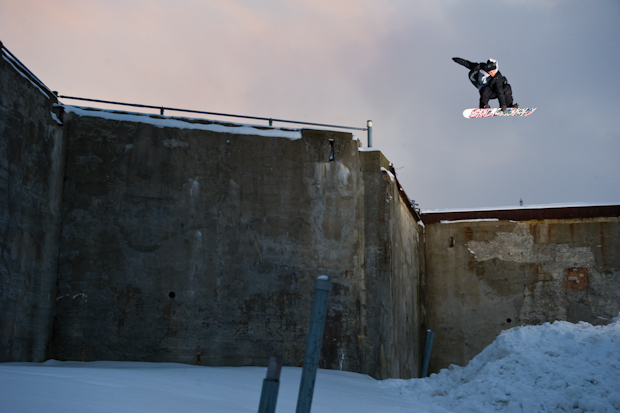
I wonder if that’s kind of the point of urban snowboarding – to fly under the radar – or to use the old cliché, ‘keep it real’. Is the explosion in jibbing a reaction to other parts of the sport selling out? “Yeah I guess. It kinda makes sense. But I’m maybe too close [to have looked at it like that before]. I’m in the middle of it, surrounded by people who do it all the time, so I get used to it.”
The parallels with street skateboarding, though – operating on the fringes of the establishment and long resistant to Olympic inclusion – are obvious. Do we still look up to skaters for their approval, I ask? “Yeah I think so. I think it’s just something we naturally do – at least the people I ride with. We look at skateboarding and find it really cool.”
Louif’s own style – understated, fluid and technical – appears to owe something to skating too. His fast-paced edits with the Videograss crew see him ride coolly out of tricks in the same upright stance favoured by most of today’s skate punks, while his recent Real Snow part opened with a triple line follow-cam shot reminiscent of… well, pretty much every skate flick since Useless Wooden Toys. “Lines are the funnest thing to me,” he explains. “It’s hard to get multiple tricks down, but it’s also a challenge for the filmer to get close enough.” But are we just blindly copying skating? “No. I don’t think it’s copying it. It’s just inspired by it. Eventually a lot of snowboarders that do urban stuff won’t even pay attention to skateboarding. They don’t need to, cos it’s a whole sub culture in itself.”
It’s certainly true that Louif is part of an exciting movement. From Quebec to Salt Lake, Tahoe to Iceland, riders are mixing skate influences with snowboarding’s sense of scale to open a whole new chapter in urban shredding. Whereas in Jeffy Anderson’s day, it was all about keeping it legit (read: ‘skate’) with natural ollie takeoffs onto rails, Louif thinks snowboarding has learned to play to its strengths. “I think it’s cool [to have a natural takeoff], but at the same time we have the luxury of taking a shovel, putting a little snow down and making the takeoff better – verses skating where you’d need concrete. If you’re gonna try a really hard trick you might as well help yourself a little bit. I’m not down for giant kickers, but a little pat or a trannie for a wallride? Why not. It’s really cool that we have that ability to just build whatever we want and shape the landscape – and then change it right away.”

The endless possibilities offered by civic architecture and a few shovel-loads of snow are in contrast to today’s park lines, which Louif thinks “are getting kinda boring now – like straight rail, straight jump. It’d be cool if there was some creativity, maybe some transitions and other stuff you don’t expect to find in a park. I can’t really blame ‘em, but a lot of resort shapers are going the easy way so it’s easy to build and maintain.”
“I don’t think what I do is copying skateboarding. It’s just inspired by it. Eventually a lot of snowboarders that do urban stuff won’t even pay attention to skateboarding. They don’t need to, cos it’s a whole sub culture in itself”
Despite all this, I put it to him that flying across the world to hang out in a city street must seem strange to a lot of folk. “For sure, it’s kinda weird,” he admits. “But for me it’s normal cos that’s the environment I grew up in; that’s what I learned to snowboard on. But I definitely find it stupid sometimes – especially when it’s not going well or we’re getting kicked out. I went to Japan in December, to film the Real Snow part. It was pretty cool but we were staying with someone who was shredding pow every day. And every evening we’d come back from two hours of traffic, and he’d be letting us know how good the snow was! Next time I wanna do what he was doing and just ride powder.”
As a straight-up lover of freshies who (I’ll be honest) doesn’t bounce like he used to, the idea of going to Japan to throw yourself down metal and concrete really does seem perverse to me. But to a committed jibber like Louif, I wonder, can the perfect rail day beat the perfect powder day? “I have some of my favourite days of the winter when I get to ride powder,” he concedes. “But it’s satisfying in a different way. With street stuff, it’s more about feeling productive – like you’ll get a video shot and a photo out of it. And that’s where I feel I can do something new, to add to what’s happening in the snowboard world. That’s my speciality. There’s so many options in the city too – I never, like, find a ceiling or get over it.”

What about the hassle? Does it get old dodging cops and dealing with angry residents? “Sometimes you don’t feel like you’re in the right place when you’re trying to snowboard, and people aren’t happy with you being there. It depends where you go. I usually try to snowboard in places where I won’t get shut down right away. I don’t like to bother anyone,” he says politely. “If you’re trying to snowboard in front of a hospital then for sure you’ll get kicked out, but if you’re in a schoolyard in the weekend, or a park, nobody will bother.”
My mind leaps instinctively to a banger shot of Louif boardsliding a church in Quebec. Not the obvious choice of ledge for someone looking to avoid raised eyebrows. “Well, if a spot looks really, really fun but it’s a bit of a sketch location then I’ll do it. But if it’s a normal spot then I’d rather go somewhere else.”
As much as Louif prefers to operate in the shadows, even he couldn’t resist the lure of publicity when, in 2011, the X Games added urban snowboarding to its annual TV circus. Dubbed ‘Real Snow’, eight of the world’s best jibbers were invited to submit one-minute movies for a public vote. “Filming a video part is what I like to do year after year, so why not do it for 50,000 dollars?” he reasons honestly. It proved a wise decision too; after getting knocked out in the first round against Dan Brisse last year, the 2012 contest saw Louif go all the way to the final, where he eventually triumphed over possibly the most popular guy in snowboarding right now: Halldor Helgason. Though the margin was fractional (just 0.03% separated the two after more than 76,000 votes) it was no mean feat – and testimony to the strength of his part, which ended with a truly mind bending wallride to back lip.
Not that the newly crowned gold medallist is totally comfortable with ESPN’s attempt to package street riding into a corporate-friendly format. “The first year you had to do the rail jam as well as the video contest, and I wasn’t really excited about that,” he says. “Snowboarding in front of a big crowd that’s expecting crazy stunts, on a set-up that’s imposed on you with no say… I’m not really a fan. I don’t respond to that kind of pressure.”
This lack of a competitive streak perhaps explains the rumour doing the rounds after this year’s X Games – that Louif almost gave up his place in the street contest to the UK’s Jamie Nicholls. Was there any truth to that? “I saw him in practice and he was killing it,” he begins. “It was pretty sick to watch him snowboard actually, cos he was better than anyone! There were a couple of reserve spots up for grabs, cos Nic Suavé and Pat Moore were hurt, so I thought after they’d seen Jamie ride in practice they’d take him. But I guess he was third on the list or something. I did think about giving him my spot, ‘cos I thought he should’ve gone. He seemed pretty excited to be there, and I think he would’ve taken at least top three.”
So he’s impressed by our most successful dome graduate? “He’s exciting in every aspect – well maybe not powder, but rails and jumps. I think he’s possibly gonna change a few things in snowboarding. From what I’ve seen, he looks very comfortable – and he’s doing hard tricks with a lot of style.”
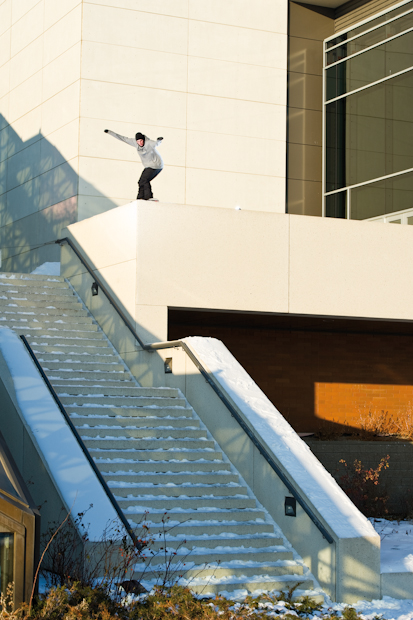
“If a spot looks really, really fun but it’s a bit of a sketch location then I’ll do it. But if it’s a normal spot then I’d rather go somewhere else”
Louif is equally generous in his praise for his Real Snow competitors. “I’m very surprised that I won against Bode [Merrill],” he gushes when I ask him what he thought of the voting format, “cos I thought his movie was really strong. And after that, beating Pat… It seemed like this year it could’ve gone the other way all the way through and still been totally accurate. Everyone did so good.”
It’s a frustratingly diplomatic answer, but then I’ve come to expect nothing less from this softly spoken rider who shrinks from the spotlight of live competition and seeks to avoid conflict – even when flirting with arrest on the street. In this respect, it’s telling that Louif has an affinity for Japan. As he puts it: “I just like the people there. They seem to be smart and everybody’s quiet and respectful.” One of the locals he met on his last trip was Taro Tamai, founder of Gentemstick – a small company in Niseko specialising in beautiful, hand-crafted powder decks. “I was with Wolle [Nyvelt] and Boris Benedek and they were trying to do a documentary about board shaping, It was really cool to go in their shop and see their photos; they’re doing something very different from what we do.” For his part, Louif rides an off-the-rack Salomon model called the Villain, which he describes as “in between soft and stiff. I can’t ride too soft a board cos it’s too loose, and I’m pretty heavy. I like to have a little bit of snap too.” Even so, the constant abuse his boards receive on walls, metal and tarmac means he gets through a fair few each year, and I wonder if he mightn’t have got inspired by the specialist nature of the Gentemsticks. Could he envisage dedicated street boards that are cheaper for kids and more disposable, like a skate deck?
“I was actually wondering about that earlier today. But I was thinking the other way – street boards should be more durable. ‘Cos more and more you see people bringing concrete and metal to the parks. It’s a good point though – you could go for disposable – but I was thinking more durable ‘cos you use less resources and hold onto the board as long as possible. At the same time, in our world right now it seems like you need something new every year. Like if the new iPhone 4S comes out then people will get rid of their brand new iPhone 4.”
“Snowboarding in front of a big crowd that’s expecting crazy stunts? I’m not a fan. I don’t respond to that kind of pressure”
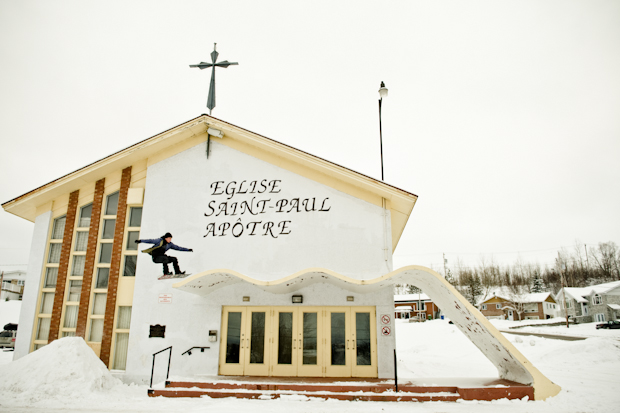
His obvious distaste for today’s disposable culture carries over to the internet. “It seems like there’s this need to feed the general public as quickly as possible, to keep people entertained,” he gripes. “People are always throwing stuff away on the internet, or it’s not high quality. Riders will release a B shot, but then you pretty much know what their A shot is already. It just needs someone to be like, ‘OK, I’m gonna hold onto my footage.’”
Louif’s preference in this regard is, once again, to follow skating’s lead: gather your footage over a couple of years, be uncompromising with the edit, and push the envelope with your final release. “Cos a year, if you get hurt, is pretty short,” He explains. “I think it’d be cool to get a really good three to four minute part where it’s all stuff you can be proud of. In a year, sometimes I feel like you’ll throw things in that you’re not psyched on, just to fill out your part.”
“Filming a video part is what I do year after year, so why not do it for $50,000?”
But even Louif admits that, having quit filming with Videograss, his next part will probably be released online. And as long as the final destination is YouTube, I venture, what hope is there for traditional movies like Absinthe or Standard? Riders can take as long as they like over their ‘parts’, but is there still a place for the complete snowboard film? “I really hope so actually,” he says. “I heard Nike are doing a two-year video project, which is gonna be pretty sick. But I dunno where I am on this subject, ‘cos it’s true that with contests like Real Snow things are changing. Now they’re doing a Backcountry Real Snow, so we’ll see a bunch of footage from those guys, and if the X Games is doing a video contest then maybe the Dew Tour will start doing it, and it’ll all become a contest. But hopefully not.”
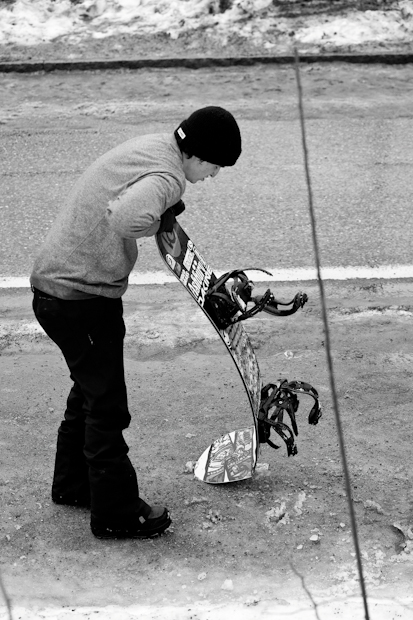
And what about the riding itself? After the intense progression we’ve witnessed over the past few years, where does he think jibbing will go in the future? “I think jibbing’s going in many directions, and that’s what’s cool about it,” he answers. “There isn’t only one way to do it. So people will decide to go really big and build never-been-done features and winch in super fast, while other people will decide to go natural speed only and return to old spots but try to do a new trick on them.”
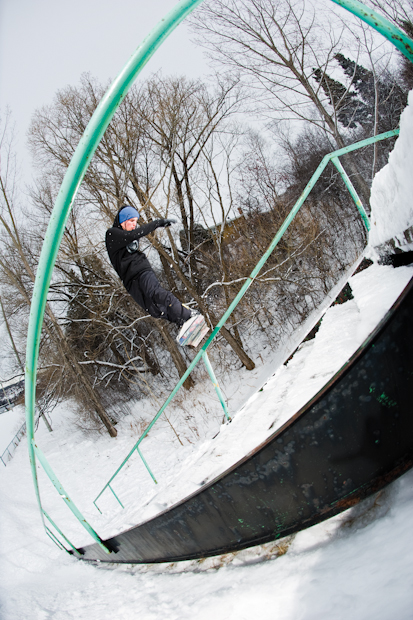
Diplomatic as ever – but what style of riding can we expect to see from Louis-Félix Paradis?
“I like natural speed a lot. I don’t like winches that much; I’d rather go back to spots in Quebec City that have seen a lot of tricks, and if someone is able to add something to it, that’s really cool. But I don’t know how to describe my style – that’s for other people to judge.”
Having just won the biggest public vote in snowboarding, it’s safe to say that other people judge his style to be pretty sick indeed.
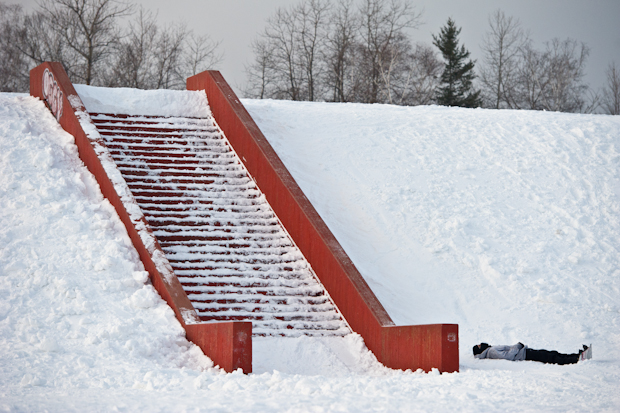
Louif on…
… the no-highback trend
“I’ve never tried it. To me it sounds a little dangerous for my ankles. But Salomon are doing a binding for next year called the Hologram, which have a soft heelcup with a pretty soft highback though, and that’s what I ride right now. I tried going back to a regular binding with a hard heelcup and it doesn’t feel as good. I feel like I don’t have the same freedom.”
… helmets
“I don’t wear a helmet; I don’t wear one to skate either. I just find it uncomfortable to wear with a beanie and goggles – kind of annoying on my head. But I think if anyone wants to wear a helmet they definitely should. I snowboard with Jed [Anderson] all the time and I don’t even notice his helmet. Hopefully no one that wants to wear a helmet thinks they can’t cos it’s not cool.”
… one-footers
“I’m cool with one-footers. I’d like to have one or two actually.”
… Jeremy Jones’ one-foot board-whips
“They’re interesting. When it’s a full part of it, back to back, it gets a bit repetitive, but when I see one or two it’s pretty cool. I don’t’ think I’ll get into though.”
… his next trick
“I’d like to do a backside 360 to nosepress, and keep it to regular. Like on a downrail or something. Ethan Deiss did one, and I’ve been thinking about it for a couple of years.”




